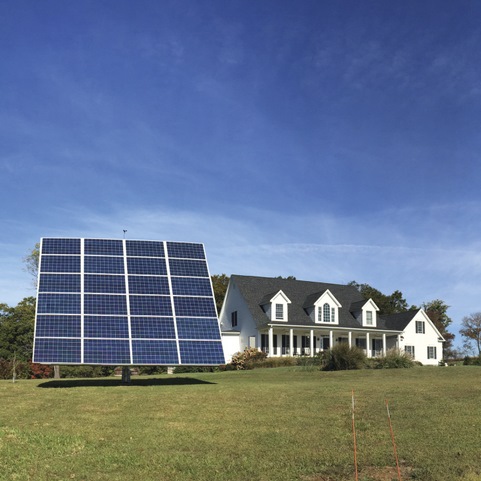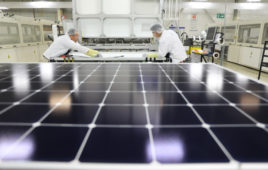The dominance of single-axis trackers in the large utility-scale solar market sometimes steals the limelight from its dual-axis cousins. But dual-axis trackers—those that follow the sun more directly than single-axis models’ east-west path—have their place in residential and commercial markets. We caught up with Vermont’s AllEarth Renewables to learn more about dual-axis solar trackers and what makes them a great choice.
AllEarth manufactures three (soon to be four) dual-axis models, each holding a table of 20 to 24 solar panels at a height of about 11 ft above the ground when flat. With an authorized dealer in almost every state, AllEarth solar trackers are available across the country.
Single-axis trackers follow the sun across a horizontal plane, but dual-axis trackers move in a more direct, circular path.
“Different manufacturers use different methods of tracking to follow the sun,” said Paul Gustafson, technical customer support for AllEarth. “The AllEarth Renewables dual-axis trackers use GPS signals to determine the tracker’s latitude and longitude, as well as the date and time. With this information, the tracker will know the position of the sun for any given time and orient itself to face the sun using a hydraulic drive system. The tracker will be facing the sun even during cloudy periods, so when the clouds part the tracker will already be positioned to maximize power production without any delays to reposition itself.”
Since the panels are always directly facing the sun, AllEarth estimates that its dual-axis trackers produce 45% more energy than a fixed-roof system and up to 30% more than a fixed-ground-mount system.
Residential customers turn to dual-axis trackers often because they have the land-space available and want to maximize their output.
“[A residential customer] has some property and is looking for a power source away from the house and not on the roof,” said Tim Post, AllEarth sales account manager. “Their roof is likely inadvisable for solar because of dormers, slate, shading, east-west alignment, aesthetic considerations or structural issues.”
Commercial customers often have the same reasoning for wanting a dual-axis tracker but with a green twist.
![]() “[Commercial customers are] often looking for the visibility for green energy cache and the PR factor,” Post said. “The commercial customer understands the greater value in being able to produce about 45% more power in the same footprint, especially when constrained by space or regulatory factors.”
“[Commercial customers are] often looking for the visibility for green energy cache and the PR factor,” Post said. “The commercial customer understands the greater value in being able to produce about 45% more power in the same footprint, especially when constrained by space or regulatory factors.”
Benefits and future outlook
As with a lot of solar developments, dual-axis trackers evolved from Europe.
“Areas like Spain have embraced the dual-axis tracker as one of the best ways to harness the sun’s power for some time,” said AllEarth president and CEO David Blittersdorf. “In America, the market evolved from a niche market for maximizing solar energy production. Location plays into this, as states have different laws regarding solar energy production and net metering.”
Dual-axis trackers obviously win the game when it comes to smaller arrays. Single-axis trackers only work if there’s enough land for a long span of panels. But dual-axis arrays can work just as well on larger projects as single-axis models—material costs are similar but dual-axis trackers produce more power since the sun is being followed more accurately. And with only one pole to work into the ground and a stow-level height at 11 ft, the land associated with dual-axis projects can continue to be used for agriculture, and vegetation management is much easier.
 Movement across two axes doesn’t automatically mean twice the amount of maintenance.
Movement across two axes doesn’t automatically mean twice the amount of maintenance.
“As with any solar system, fixed or tracking, AllEarth Renewables trackers should have an annual inspection to ensure the system is working properly,” Gustafson said. “The inspection should confirm that the inverter and panels are producing and that the system is tracking properly. The only scheduled maintenance recommended for the AllEarth trackers is a hydraulic fluid change every eight to 10 years.”
To stay on top of this niche market, the AllEarth team is constantly working on ways to improve cost, reliability and monitoring with its dual-axis trackers. AllEarth’s new Gen 4 model (out in 2018) will be self-powered, drawing energy directly from its panels so it will work even if the grid is down. The new tracker will also be Wi-Fi, cellular and SD card-enabled, expanding its communication options.
“We plan to keep finding ways for people to get more from the sun with our dual-axis trackers,” Blittersdorf said. “We plan to continue with the release of Gen 4 and get it ready for installations and sales for the 2018 year. Father down the line we plan to keep releasing innovative products that allow people to harness the full potential of renewables.”




I made a simple and small dual axis solar tracker. here is the link below.
https://www.youtube.com/watch?v=7076aoRs1vs&t=31s
If you want any help regarding the project email me at : abdullahalom03@gmail.com
Very good. Put figures on it!